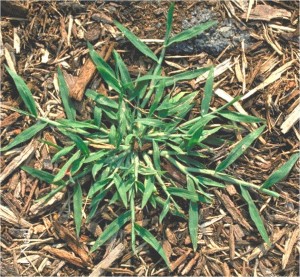Crabgrass is an annual grassy weed which dies out around the first autumn frost. Seeds dropped last summer germinate when the soil warms up from early spring through summer. When spring soil temperatures reach 55-60 degrees (the forsythia shrub is blooming), apply a pre-emergent crabgrass preventative. These herbicides are very effective applied in late winter and again in early July in the Southern Appalachian region (USDA zones 6 and 7).
Some additional lawn care tips to reduce crabgrass infestations:
1.) Spring lawn fertilizing. A thick lawn keeps out crabgrass by making it harder for the crabgrass seeds to sprout. Split apply a slow release lawn fertilizer in late winter and again in mid-spring at the equivalent rate of 2 lbs of actual nitrogen per 1000 sq. ft.
2.) Mow high. A thick, tall lawn grass keeps the soil temperatures cooler and prevents sunlight from lighting the soil. Short mowing weakens the grass, and warms up the soil, making crabgrass seed easy to germinate. Seeds don’t germinate well over shaded ground.
3.) Delay lawn renovation (reseeding bare spots) until fall. In the spring lawn seed germinates in a few weeks, but crabgrass seed comes up faster. Fall seeding is better because crabgrass is dying and new lawn seeding germinates and grows rapidly without crabgrass competition.
4.) Dethatch and aerify lawns in early fall. Crabgrass loves compacted soils. Soil aerification, if needed, is best delayed until fall because you are opening the ground, favoring crabgrass seed germination.
5.) Lime, if needed, in the late fall. Lime raises the soil pH. The proper soil pH allows more nutrient uptake to the lawn grass which means a healthier growing turf.


 Posted in
Posted in 
